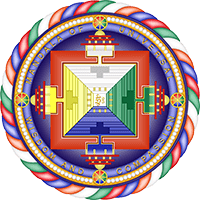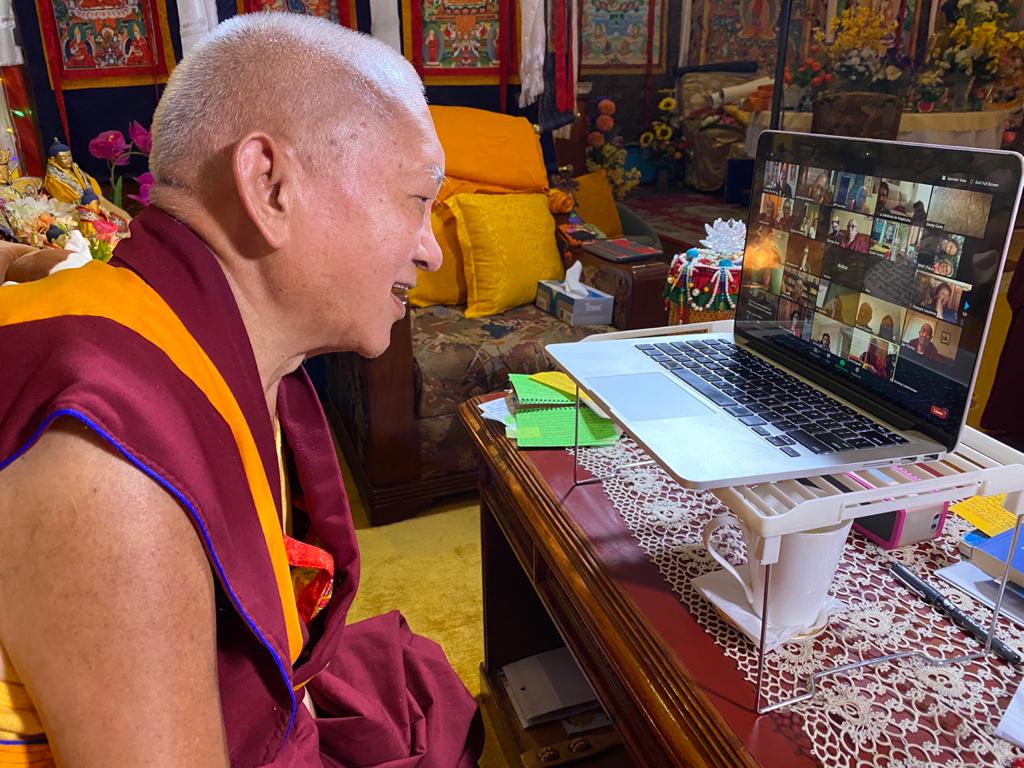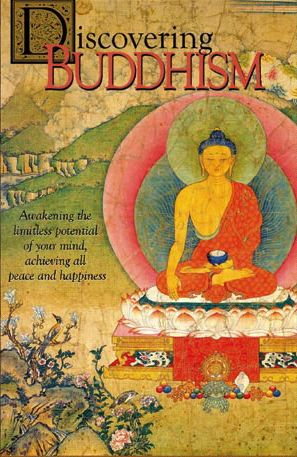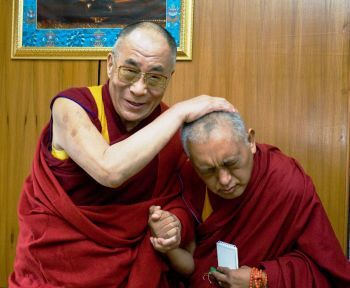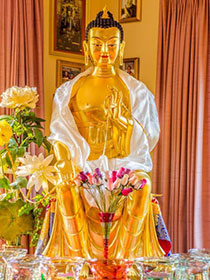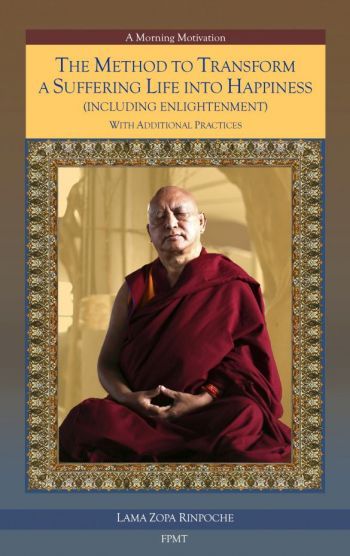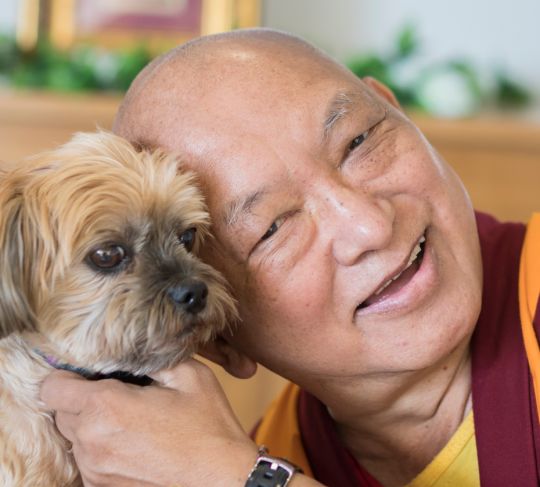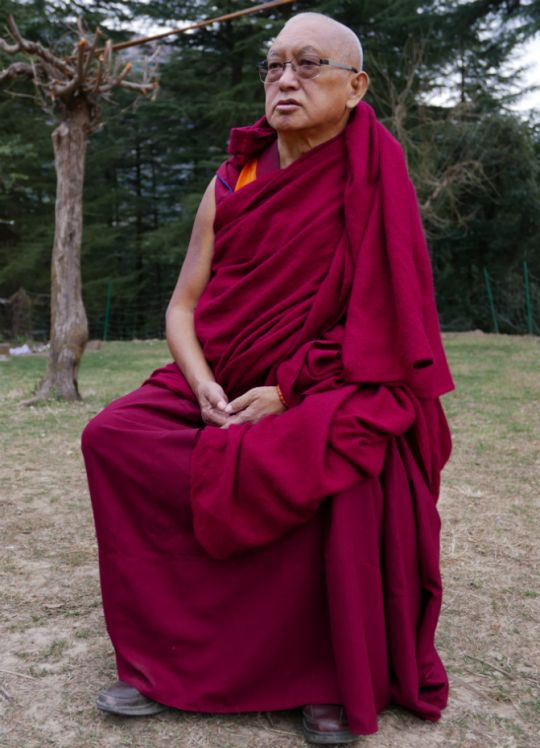- Home
- FPMT Homepage
Foundation for the Preservation of the Mahayana Tradition
The FPMT is an organization devoted to preserving and spreading Mahayana Buddhism worldwide by creating opportunities to listen, reflect, meditate, practice and actualize the unmistaken teachings of the Buddha and based on that experience spreading the Dharma to sentient beings. We provide integrated education through which people’s minds and hearts can be transformed into their highest potential for the benefit of others, inspired by an attitude of universal responsibility and service. We are committed to creating harmonious environments and helping all beings develop their full potential of infinite wisdom and compassion. Our organization is based on the Buddhist tradition of Lama Tsongkhapa of Tibet as taught to us by our founders Lama Thubten Yeshe and Lama Thubten Zopa Rinpoche.
- Willkommen
Die Stiftung zur Erhaltung der Mahayana Tradition (FPMT) ist eine Organisation, die sich weltweit für die Erhaltung und Verbreitung des Mahayana-Buddhismus einsetzt, indem sie Möglichkeiten schafft, den makellosen Lehren des Buddha zuzuhören, über sie zur reflektieren und zu meditieren und auf der Grundlage dieser Erfahrung das Dharma unter den Lebewesen zu verbreiten.
Wir bieten integrierte Schulungswege an, durch denen der Geist und das Herz der Menschen in ihr höchstes Potential verwandelt werden zum Wohl der anderen – inspiriert durch eine Haltung der universellen Verantwortung und dem Wunsch zu dienen. Wir haben uns verpflichtet, harmonische Umgebungen zu schaffen und allen Wesen zu helfen, ihr volles Potenzial unendlicher Weisheit und grenzenlosen Mitgefühls zu verwirklichen.
Unsere Organisation basiert auf der buddhistischen Tradition von Lama Tsongkhapa von Tibet, so wie sie uns von unseren Gründern Lama Thubten Yeshe und Lama Thubten Zopa Rinpoche gelehrt wird.
- Bienvenidos
La Fundación para la preservación de la tradición Mahayana (FPMT) es una organización que se dedica a preservar y difundir el budismo Mahayana en todo el mundo, creando oportunidades para escuchar, reflexionar, meditar, practicar y actualizar las enseñanzas inconfundibles de Buda y en base a esa experiencia difundir el Dharma a los seres.
Proporcionamos una educación integrada a través de la cual las mentes y los corazones de las personas se pueden transformar en su mayor potencial para el beneficio de los demás, inspirados por una actitud de responsabilidad y servicio universales. Estamos comprometidos a crear ambientes armoniosos y ayudar a todos los seres a desarrollar todo su potencial de infinita sabiduría y compasión.
Nuestra organización se basa en la tradición budista de Lama Tsongkhapa del Tíbet como nos lo enseñaron nuestros fundadores Lama Thubten Yeshe y Lama Zopa Rinpoche.
A continuación puede ver una lista de los centros y sus páginas web en su lengua preferida.
- Bienvenue
L’organisation de la FPMT a pour vocation la préservation et la diffusion du bouddhisme du mahayana dans le monde entier. Elle offre l’opportunité d’écouter, de réfléchir, de méditer, de pratiquer et de réaliser les enseignements excellents du Bouddha, pour ensuite transmettre le Dharma à tous les êtres. Nous proposons une formation intégrée grâce à laquelle le cœur et l’esprit de chacun peuvent accomplir leur potentiel le plus élevé pour le bien d’autrui, inspirés par le sens du service et une responsabilité universelle. Nous nous engageons à créer un environnement harmonieux et à aider tous les êtres à épanouir leur potentiel illimité de compassion et de sagesse. Notre organisation s’appuie sur la tradition guéloukpa de Lama Tsongkhapa du Tibet, telle qu’elle a été enseignée par nos fondateurs Lama Thoubtèn Yéshé et Lama Zopa Rinpoché.
Visitez le site de notre Editions Mahayana pour les traductions, conseils et nouvelles du Bureau international en français.
Voici une liste de centres et de leurs sites dans votre langue préférée
- Benvenuto
L’FPMT è un organizzazione il cui scopo è preservare e diffondere il Buddhismo Mahayana nel mondo, creando occasioni di ascolto, riflessione, meditazione e pratica dei perfetti insegnamenti del Buddha, al fine di attualizzare e diffondere il Dharma fra tutti gli esseri senzienti.
Offriamo un’educazione integrata, che può trasformare la mente e i cuori delle persone nel loro massimo potenziale, per il beneficio di tutti gli esseri, ispirati da un’attitudine di responsabilità universale e di servizio.
Il nostro obiettivo è quello di creare contesti armoniosi e aiutare tutti gli esseri a sviluppare in modo completo le proprie potenzialità di infinita saggezza e compassione.
La nostra organizzazione si basa sulla tradizione buddhista di Lama Tsongkhapa del Tibet, così come ci è stata insegnata dai nostri fondatori Lama Thubten Yeshe e Lama Zopa Rinpoche.
Di seguito potete trovare un elenco dei centri e dei loro siti nella lingua da voi prescelta.
- 欢迎 / 歡迎
简体中文
“护持大乘法脉基金会”( 英文简称:FPMT。全名:Foundation for the Preservation of the Mahayana Tradition) 是一个致力于护持和弘扬大乘佛法的国际佛教组织。我们提供听闻,思维,禅修,修行和实证佛陀无误教法的机会,以便让一切众生都能够享受佛法的指引和滋润。
我们全力创造和谐融洽的环境, 为人们提供解行并重的完整佛法教育,以便启发内在的环宇悲心及责任心,并开发内心所蕴藏的巨大潜能 — 无限的智慧与悲心 — 以便利益和服务一切有情。
FPMT的创办人是图腾耶喜喇嘛和喇嘛梭巴仁波切。我们所修习的是由两位上师所教导的,西藏喀巴大师的佛法传承。
繁體中文
護持大乘法脈基金會”( 英文簡稱:FPMT。全名:Found
ation for the Preservation of the Mahayana Tradition ) 是一個致力於護持和弘揚大乘佛法的國際佛教組織。我們提供聽聞, 思維,禪修,修行和實證佛陀無誤教法的機會,以便讓一切眾生都能 夠享受佛法的指引和滋潤。 我們全力創造和諧融洽的環境,
為人們提供解行並重的完整佛法教育,以便啟發內在的環宇悲心及責 任心,並開發內心所蘊藏的巨大潛能 — 無限的智慧與悲心 – – 以便利益和服務一切有情。 FPMT的創辦人是圖騰耶喜喇嘛和喇嘛梭巴仁波切。
我們所修習的是由兩位上師所教導的,西藏喀巴大師的佛法傳承。 察看道场信息:
- FPMT Homepage
- News/Media
-
- Study & Practice
-
-
- About FPMT Education Services
- Latest News
- Programs
- New to Buddhism?
- Buddhist Mind Science: Activating Your Potential
- Heart Advice for Death and Dying
- Discovering Buddhism
- Living in the Path
- Exploring Buddhism
- FPMT Basic Program
- FPMT Masters Program
- FPMT In-Depth Meditation Training
- Maitripa College
- Lotsawa Rinchen Zangpo Translator Program
- Universal Education for Compassion & Wisdom
- Online Learning Center
-
- Prayers & Practice Materials
- Overview of Prayers & Practices
- Full Catalogue of Prayers & Practice Materials
- Explore Popular Topics
- Benefiting Animals
- Chenrezig Resources
- Death & Dying Resources
- Lama Chopa (Guru Puja)
- Lama Zopa Rinpoche: Compendium of Precious Instructions
- Lama Zopa Rinpoche: Life Practice Advice
- Lama Zopa Rinpoche Practice Series
- Lamrim Resources
- Mantras
- Prayer Book Updates
- Purification Practices
- Sutras
- Thought Transformation (Lojong)
- Audio Materials
- Dharma Dates - Tibetan Calendar
- Translation Services
- Publishing Services
- Ways to Offer Support
- Prayers & Practice Materials
-
- Teachings and Advice
- Find Teachings and Advice
- Lama Zopa Rinpoche Advice Page
- Lama Zopa Rinpoche: Compendium of Precious Instructions
- Lama Zopa Rinpoche Video Teachings
- ༧སྐྱབས་རྗེ་བཟོད་པ་རིན་པོ་ཆེ་མཆོག་ནས་སྩལ་བའི་བཀའ་སློབ་བརྙན་འཕྲིན།
- Podcasts
- Lama Yeshe Wisdom Archive
- Buddhism FAQ
- Dharma for Young People
- Resources on Holy Objects
- Teachings and Advice
-
-
*If a menu item has a submenu clicking once will expand the menu clicking twice will open the page.
-
-
- Centers
-
- Teachers
-
- Projects
-
-
-
-
*If a menu item has a submenu clicking once will expand the menu clicking twice will open the page.
-
-
- FPMT
-
-
-
-
-
I want to say without hesitation that the purpose of our life is happiness.
His Holiness the Dalai Lama
-
-
-
- Shop
-
-
-
The Foundation Store is FPMT’s online shop and features a vast selection of Buddhist study and practice materials written or recommended by our lineage gurus. These items include homestudy programs, prayers and practices in PDF or eBook format, materials for children, and other resources to support practitioners.
Items displayed in the shop are made available for Dharma practice and educational purposes, and never for the purpose of profiting from their sale. Please read FPMT Foundation Store Policy Regarding Dharma Items for more information.
-
-
Lama Zopa Rinpoche News and Advice
15
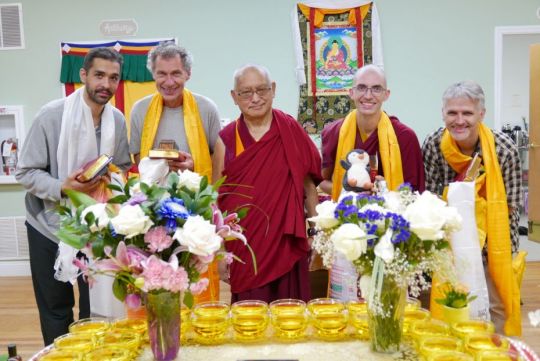
Lama Zopa Rinpoche with the media team members Alexis, Tione, Ven. Rinchen, and Harald, Light of the Path retreat, August 2016. Photo by Ven. Roger Kunsang.
In this short video clip from a teaching given at the 2016 Light of the Path retreat, Lama Zopa Rinpoche urges us to liberate ourselves from samsara. Rinpoche instructs us that when our husband or wife meets somebody and has a relationship with that person, we have to remember the six shortcomings of samsara.
“There is nothing definite in samsara; the friend, enemy, stranger changes. In the morning they are a friend, in the evening an enemy, in the afternoon a friend, in the evening an enemy, today a friend, tomorrow an enemy, a friend this week, next week an enemy, this month a friend, next month enemy, this year friend, next year friend,” Rinpoche says.
Our relationship with that person also changes from life to life, and it has been like this from beginningless rebirths. Rinpoche says, “In beginningless samsara you have been friends, enemies, and strangers numberless times. You see, that is the nature of samsara.”
Rinpoche continues, “If you yourself are free from samsara then you don’t have to be attached. If you don’t have to be attached, then you don’t have to be angry. You are unattached. You don’t need it at all. You are totally free.”
Rinpoche then explains where we made our mistake. “Because you didn’t actualize the four noble truths, the true cause of suffering, true cessation, and the true path; because of that mistake, you are still in samsara; and torture yourself all the time,” he says. “I have to say it that way, otherwise it is just words, the lamrim is just words. It is really talking about life, so you need to practice.”
He recommends starting with renunciation and not thinking that the other person is torturing us: “No, think that it is your own problem because in the past life you didn’t actualize the path. In this life you didn’t actualize the path.”
Next, practice bodhichitta. “That sentient being is totally controlled by attachment. It is the same as being possessed by a spirit. You need to help them. As you meditate on kindness while walking, it is so important to help, to practice kindness.”
Then, reflect on emptiness. Rinpoche says, “All the rest is hallucination. There can be great peace when you think of hallucination. We don’t have to speak of tantra; just lamrim is amazing.”
Watch “The Six Shortcomings of Samsara” on YouTube:
https://youtu.be/t6J73iyuTxw
The quotes from Lama Zopa Rinpoche have been edited and are based on the unedited transcript of the 2016 Light of the Path retreat, which you can find here with video recordings of the complete teachings:
https://fpmt.org/media/streaming/teachings-of-lama-zopa-rinpoche/light-of-the-path-teachings-2016/
Find and watch video from all of Rinpoche’s recent teachings events, including from Chan Tong Chen Tong Centre in Tasmania and the Great Stupa of Universal Compassion in Bendigo, Australia:
https://fpmt.org/media/streaming/teachings-of-lama-zopa-rinpoche/
Lama Zopa Rinpoche is the spiritual director of the Foundation for the Preservation of Mahayana Tradition (FPMT), a Tibetan Buddhist organization dedicated to the transmission of the Mahayana Buddhist tradition and values worldwide through teaching, meditation, and community service.
4
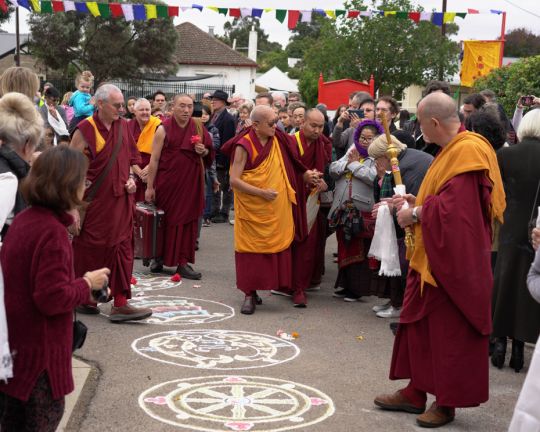
Lama Zopa Rinpoche arriving at Buddha House, Adelaide, Australia, May 2018. Photo by Ven. Lobsang Sherab.
In this short video clip from a teaching given at the 2016 Light of the Path retreat, Lama Zopa Rinpoche, while explaining the meaning of a Tibetan phase, discusses the importance of studying one path well in order to avoid confusion and the degeneration of one’s wisdom.
“Keep your wisdom in the pure path,” Lama Zopa Rinpoche instructs. “Pure view, pure conduct, a subdued mind, wisdom.”
In order to do this, Rinpoche advises to not dilute and confuse your efforts by trying many types of teachings.
“You start this, then start this, start this, start this,” Rinpoche says with this hand gesturing in different directions. “Then your wisdom is not set in the best direction, best view, best conduct.”
You even become unsure and unclear about Lama Tsongkhapa’s teachings, Rinpoche explains. When you try different things, “at the end you are lost, at the end you are not sure, you are confused.”
However, after studying well on one path and making sure that you have correct meditation, conduct, and view, Rinpoche says, then when you learn about other paths, due to that correct basis, you are able to understand, to recognize other methods and paths, and to be able to discriminate between them.
It is like going to a buffet at a restaurant and tasting all the different food. If you do that with the teachings, you could end up like someone for whom Lama Tsongkhapa’s teachings mean nothing.
“What is mediation, what is conduct, what is pure view—the real path,” Rinpoche warns that those things could mean nothing to you. “You are lost.”
Watch “Keep Your Wisdom with Pure View and Conduct” on YouTube:
https://youtu.be/i_Xr4CuIb00
The quotes from Lama Zopa Rinpoche have been edited and are based on the unedited transcript of the 2016 Light of the Path retreat, which you can find here with video recordings of the complete teachings:
https://fpmt.org/media/streaming/teachings-of-lama-zopa-rinpoche/light-of-the-path-teachings-2016/
Find and watch video from all of Rinpoche’s recent teachings events, including from Chan Tong Chen Tong Centre in Tasmania and the Great Stupa of Universal Compassion in Bendigo, Australia:
https://fpmt.org/media/streaming/teachings-of-lama-zopa-rinpoche/
Lama Zopa Rinpoche is the spiritual director of the Foundation for the Preservation of Mahayana Tradition (FPMT), a Tibetan Buddhist organization dedicated to the transmission of the Mahayana Buddhist tradition and values worldwide through teaching, meditation, and community service.
1
Lama Zopa Rinpoche advised a student seeking life practice advice to make the most of their life by practicing lamrim and bodhicihtta, thereby bring as much benefit as possible to all sentient beings.
Practice lamrim and bodhichitta, so that everything you do is with the motivation of bodhichitta, in order to free numberless sentient beings from the oceans of samsaric sufferings and bring them to buddhahood, the peerless happiness. Think, “For that I have to achieve full enlightenment, therefore I am going to do this action with bodhichitta, whatever it is—going to work, eating, working, sleeping, and so forth.” Practice mindfulness as much as possible, like that. In this way all your activities, such as walking, sleeping, or doing your job, are done with bodhichitta. Then every action becomes the cause of enlightenment and you collect more than skies of merit.
For example, if you generate bodhichitta and then recite OM MANI PADME HUM one hundred and eight times, when you recite the mantras for numberless sentient beings you collect more than skies of merit and good luck with each mantra.
If you are going to the stupa to circumambulate, generate bodhichitta at the beginning, then each time you go around the stupa it becomes the cause of enlightenment and you collect more than skies of merit with each step.
The same thing when you go to the market with bodhichitta. Whether you are coming or going, everything you do, even sleeping, each minute you sleep becomes the cause of enlightenment and you collect more than skies of merit if these actions are done with bodhichitta.
That is my main advice. Whatever you do in this way, by generating bodhichitta, you benefit every single hell being, hungry ghost, and animal—all those in the ocean the size of a mountain and those beings that are the smallest size, like fleas; those that live on the ground, in the trees and in the sky—and also human beings, suras, asuras, and intermediate state beings, including every sentient being, there is not one left out. All your actions benefit every single sentient being.
This advice, “Whether to Remove Deity Tattoos,” is from “Lama Zopa Rinpoche’s Online Advice Book,” published in February 2018 on the Lama Yeshe Wisdom Archive website:
https://www.lamayeshe.com/advice/whether-remove-deity-tattoos
Lama Zopa Rinpoche is the spiritual director of the Foundation for the Preservation of Mahayana Tradition (FPMT), a Tibetan Buddhist organization dedicated to the transmission of the Mahayana Buddhist tradition and values worldwide through teaching, meditation, and community service.
- Tagged: bodhichitta, lama zopa rinpoche
25
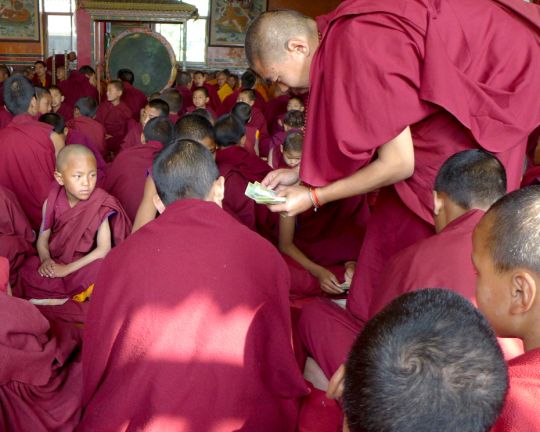
Making offerings to monks during Losar at Kopan Monastery, Nepal, February 2017. Photo by Laura Miller.
Lama Zopa Rinpoche answered a student’s question about why monks receive offerings before nuns during pujas, and advised that if the student makes offerings to the pores of the guru then the student will collect the same merit as having offered to numberless buddhas, Dharma, Sangha, statues, stupas, and scriptures.
When making offerings to Sangha in pujas, generally people offer first to the monks and then to the nuns. Actually this is probably more a Tibetan custom, as in Tibet even the lay people do this. The women also do this; they always offer to the men first.
From my side, how I think is that you could offer to each monk and nun at the same time. So you could have two people making offerings to monks and nuns at the same time, down the two rows.
Probably you have not heard, but I am not sure. Anyway, when you are making offerings, whether to lay people or Sangha, if they have received teachings from His Holiness the Dalai Lama, and if they have the same guru as you—such as His Holiness the Dalai Lama or the center geshe—think that every one of the students is the pores of your guru. If you think that as you make offerings, then you collect unbelievable merit.
You collect more merit than having made offerings to numberless buddhas, Dharma, and Sangha, and numberless statues, stupas, and scriptures in the ten directions. You collect much more merit by thinking that they are the guru’s pores and then making the offering, even to lay people. Even giving a glass of water, a piece of fruit, a biscuit, or one nut to a lay person who is a disciple of His Holiness or the center geshe, who is also your guru. By thinking that this person is the guru’s pore and then offering one biscuit or one piece of candy, you collect much more merit than having made offerings to numberless buddhas, Dharma, Sangha, and numberless statues, stupas, and scriptures in the ten directions.
This is not just in a puja. This refers to any time.
That’s why I say at the centers, don’t think that to collect merit you always have to offer to the monasteries. You can collect so much merit at the center, right there, by offering to the students who have the same guru as you. However many students there are, you can make offerings to them, and you will collect the same merit as having offered to numberless buddhas, Dharma, Sangha, statues, stupas, and scriptures. There are so many students.
This advice, “Burning Holy Objects and Offering to Sangha,” is from “Lama Zopa Rinpoche’s Online Advice Book,” published in March 2018 on the Lama Yeshe Wisdom Archive website:
https://www.lamayeshe.com/advice/burning-holy-objects-and-offering-sangha
Lama Zopa Rinpoche is the spiritual director of the Foundation for the Preservation of Mahayana Tradition (FPMT), a Tibetan Buddhist organization dedicated to the transmission of the Mahayana Buddhist tradition and values worldwide through teaching, meditation, and community service.
- Tagged: offering
21
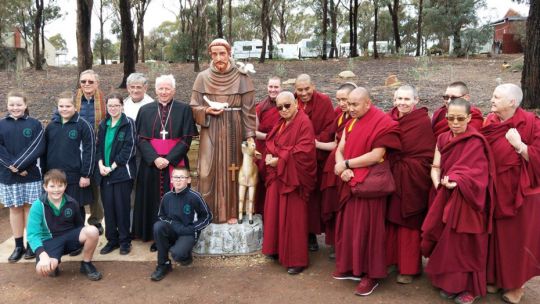
Group photo with Bishop Leslie Rogers Tomlinson, Lama Zopa Rinpoche, and Saint Francis of Assisi statue, Bendigo, Australia, May 2018. Photo courtesy of Owen Cole.
On May 12, 2018, as the Bodhicaryavatara and Rinjung Gyatsa Retreat with Lama Zopa Rinpoche drew to a close, some of the retreat participants were able to join in the unveiling and blessing of a new statue at the Peace Park outside of the retreat venue, The Great Stupa of Universal Compassion. Long-time Australian student Owen Cole shared this story of interfaith harmony in Bendigo, Australia:
The renunciation and compassion of Saint Francis of Assisi was acknowledged in the closing stages of the retreat in Bendigo with an interfaith blessing of a life-size statue of the famous twelfth-century Catholic monk.
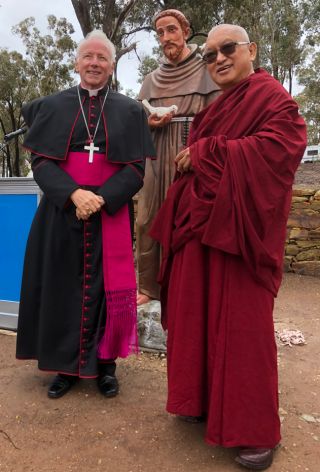
Bishop Leslie Rogers Tomlinson and Lama Zopa Rinpoche with the statue of Saint Francis of Assisi, Bendigo, Australia, May 2018. Photo by Ven. Roger Kunsang.
The statue is the first item to be placed in an interfaith Peace Park on the grounds of The Great Stupa of Universal Compassion. It will be joined by religious works from other faiths and was blessed by the Catholic Bishop of Sandhurst, Bishop Leslie Rogers Tomlinson, and Lama Zopa Rinpoche.
Bishop Tomlinson said Saint Francis, the patron saint of the environment and animals, through his life of simplicity and poverty invites us to look at our present-day culture of excessiveness.
Rinpoche, who has deep respect for the saint, said Saint Francis renounced attachment to the pleasures of this life and through his miracles, showed great spiritual attainment.
During his April 28 teaching at the retreat, Rinpoche talked about Saint Francis, saying, “Saint Francis wore ragged clothes, with many holes and patches, very similar to the Kadampa geshes, renounced practitioners. He was wearing ragged clothing, but his mind is actually the same as a bodhisattva.”
Rinpoche went on to explain that just like the bodhisattvas who can stop floods, Saint Francis of Assisi stopped the water from flowing in Assisi so his disciples could meditate in silence.
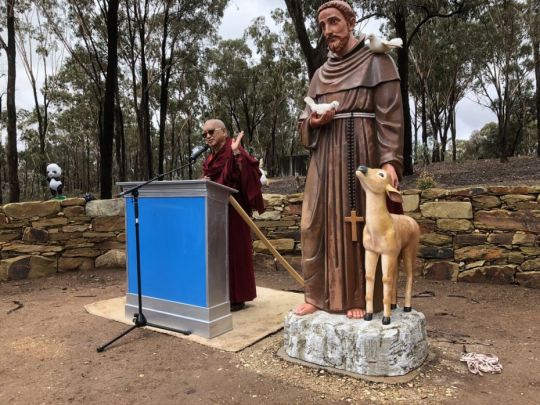
Lama Zopa Rinpoche addressing the audience, Bendigo, Australia, May 2018. Photo by Ven. Roger Kunsang.
Rinpoche added, “We have in Tibet many statutes who spoke to great yogis or those who actualized bodhichitta, those who actualized the higher path, many in Tibet and Nepal, even in Solu Khumbu. Similarly, a picture of Jesus spoke to Saint Francis of Assisi.”
Watch Ven. Tenzin Tsultim’s video of the Unveiling of the St. Francis of Assisi statue:
https://youtu.be/mSyFsHBT51Q
Additions to the Peace Park will include an Ik Onkar, a 2-meter (6.5-foot) high character-symbol that represents a central tenet of Sikh philosophy, from the Sikh community; a 1.5-meter (5-foot) high mosaic from the Islamic Council of Victoria to be incorporated into an installation that recalls a story from the Quran; a statue of Ganesh from the Hindu community; a statue from The Church of Jesus Christ of Latter-day Saints; and a representation from the local Aboriginal community.
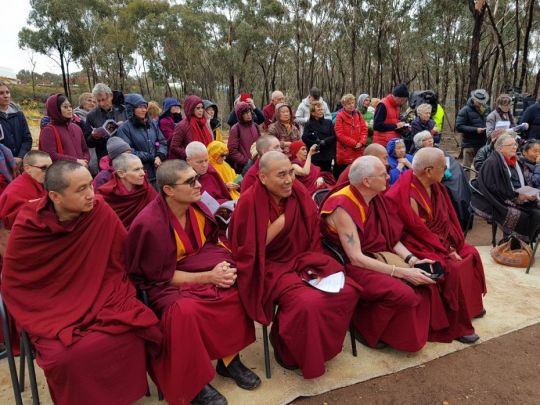
Gathered for the interfaith blessing, Bendigo, Australia, May 2018. Photo courtesy of Ian Green’s Twitter page.
Ian Green, director of The Great Stupa, also spoke at the event, commenting that FPMT is establishing Buddhism in the West and, as Australia is a multicultural and new country, The Great Stupa should reflect that.
“Rinpoche and His Holiness the Dalai Lama both thought it was a good idea to use the stupa to foster interfaith harmony,” Ian said.
The statue of Saint Francis was sponsored by the Catholic Church and will remain their property but will be maintained by the stupa organization.
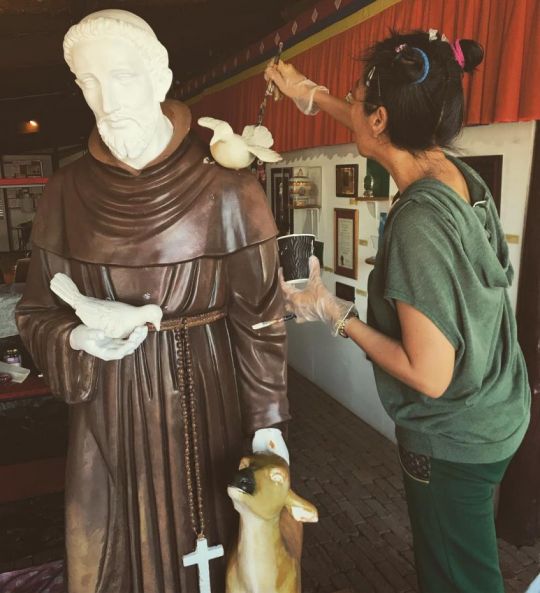
Artist Lucy Wang, who also contributed to the artwork inside The Great Stupa, painting the Saint Francis of Assisi statue, Bendigo, Australia, April 2018. Photo courtesy of The Great Stupa’s Instagram page.
Watch Lama Zopa Rinpoche’s teachings from the Bodhicaryavatara and Rinjung Gyatsa Retreat in Australia:
https://fpmt.org/media/streaming/teachings-of-lama-zopa-rinpoche/lama-zopa-rinpoche-teachings-in-bendigo-2018/
Lama Zopa Rinpoche is the spiritual director of the Foundation for the Preservation of Mahayana Tradition (FPMT), a Tibetan Buddhist organization dedicated to the transmission of the Mahayana Buddhist tradition and values worldwide through teaching, meditation, and community service.
- Tagged: australia retreat 2018, bendigo, bishop leslie rogers tomlinson, great stupa of universal compassion, interfaith, lucy wang, saint francis of assisi
19
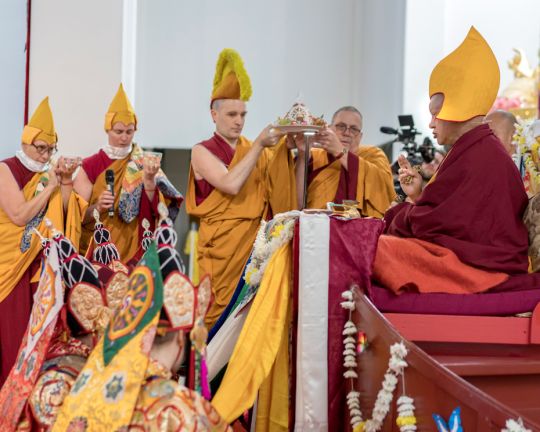
Offering tsog during long life puja for Lama Zopa Rinpoche, Great Stupa of Universal Compassion, Australia, May 2018. Photo by Ven. Lobsang Sherab.
The six-week long Bodhicaryavatara (A Guide to the Bodhisattva’s Way of Life) and Rinjung Gyatsa Retreat at the Great Stupa of Universal Compassion in Bendigo, Australia, came to a conclusion on Saturday, May 12. Ven. Holly Ansett, executive assistant to FPMT CEO Ven. Roger Kunsang, and long-time Australian student Owen Cole shared their reports on the retreat:
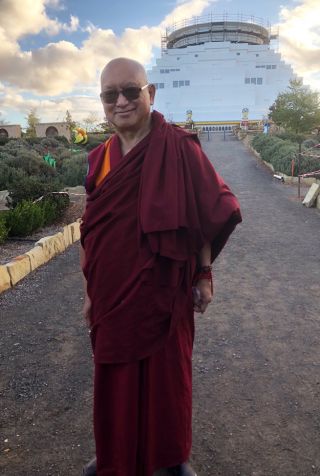
Lama Zopa Rinpoche at the Great Stupa of Universal Compassion, Bendigo, Australia, May 2018. Photo by Ven. Roger Kunsang.
Throughout the six-week Bodhicaryavatara and Rinjung Gyatsa Retreat with Lama Zopa Rinpoche, participants commented to each other that something special was going on, that this retreat was unique, profound, and very precious. In other words, all the conditions had come together for deep and transforming practice.
One long-time student speaking about the retreat told Owen Cole that “the ground shifted.”
“By that they meant that even though many of the long-time students who attended the retreat had heard the information conveyed in the teachings before, this time the message penetrated deeper,” Owen wrote.
Rinpoche himself remarked at the end of the retreat that everything went well and had been extremely harmonious and peaceful.
One of the reasons for this, Rinpoche said, was that all the retreat participants did Lama Chöpa Jorcho practice for several hours every morning exactly the way that Rinpoche had instructed.
Earlier in the retreat, Rinpoche had said there was no rush in doing the practice. So for six weeks, participants, led by the beautiful voice of Ven. Thubten Dechen, chanted the tunes—slowly, melodically, and mostly in Tibetan—just as Rinpoche had indicated.
Doing it this way, Rinpoche said, “softened the mind” and created the beneficial conditions.
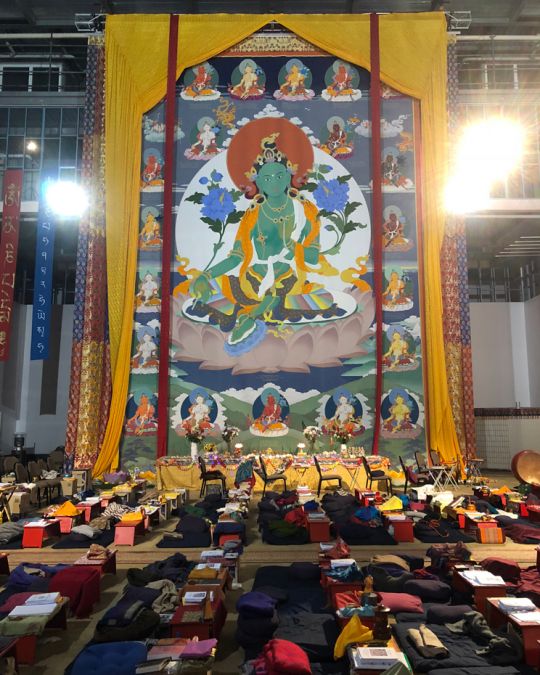
A giant Tara thangka painted by Peter Iseli hung in The Great Stupa during the retreat. One day Rinpoche taught on the importance of very large thangkas, Australia, May 2018. Photo by Ven. Roger Kunsang.
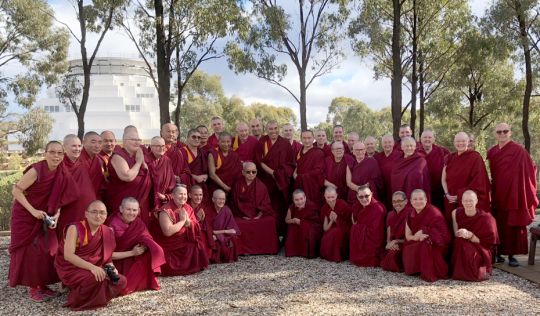
Lama Zopa Rinpoche and Sangha pose for a group photo after a lunch in the Stupa Cafe offered by Rinpoche to Sangha, Great Stupa of Universal Compassion, Australia, May 2018. Photo by Ven. Roger Kunsang.
During the last two weeks of the retreat, Rinpoche gave a Heruka initiation over several days. Rinpoche also gave five initiations from the Rinjung Gyatsa set of 305 initiations and a Lama Tsongkhapa long life initiation for Ven. Thubten Gyatso, a senior student and director of the nearby Thubten Shedrup Ling Monastery.
Rinpoche gave an unprecedented number of teachings during the retreat, all of which were streamed live online and are now available to watch as streaming video.
Rinpoche’s experiential teachings covered lamrim topics, emphasizing correctly following the guru in thought and action, and bodhichitta.
Rinpoche’s concluding teaching for the retreat, on May 11, was on the Twelve Links of Dependent Origination—a teaching he had received from Geshe Sopa Rinpoche—and the meaning of the popular Wheel of Life image.
After the concluding teaching, a deeply felt thank you mandala was offered to Rinpoche.
Ven. Gyatso and Ian Green, director of The Great Stupa of Universal Compassion, spoke on behalf of the Heart of Wisdom board, which was the body responsible for organizing the retreat. They acknowledged the contributions and hard work of their fellow board members, including Ruby Karmay, director of Atisha Centre, which is located adjacent to The Great Stupa.
Ven. Tenzin Tsapel, who coordinated the spiritual program for the retreat following all of Rinpoche’s wishes, was also thanked. The retreat coordinator, Ven. Losang Dorje, was praised for the excellent work he did organizing all of the details and offered a round of applause. Ian gave a brief summary report of the retreat’s expenses.
Ven. Dorje then thanked all the volunteer teams—gompa, office, and grounds and maintenance— that allowed retreat participants to focus on practice without worry of other things. The transcription work of Ven. Joan Nicell and the work of the live interpreters were also acknowledged. In addition many, many others not named here were thanked.
At one point during the retreat, Rinpoche commented to Ven. Roger Kunsang that these teachings on Bodhicaryavatara and the Rinjung Gyatsa initiations are extremely important for the FPMT organization.
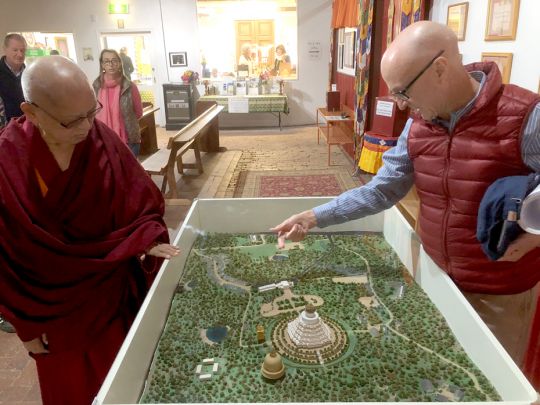
Lama Zopa Rinpoche and Ian Green looking at a model of the master plan for The Great Stupa of Universal Compassion and grounds. Rinpoche and Ian met many times during the retreat to discuss sacred art for the stupa and future development. Photo by Ven. Roger Kunsang.
During the afternoon of May 11, a large Saint Francis of Assisi statue was unveiled in the Peace Park on the grounds of The Great Stupa. Rinpoche and the Catholic Bishop of Sandhurst, Bishop Leslie Rogers Tomlinson, blessed the statue.
Meanwhile retreat participants cleaned and decorated the gompa inside The Great Stupa in preparation for the following day’s long life puja for Rinpoche.
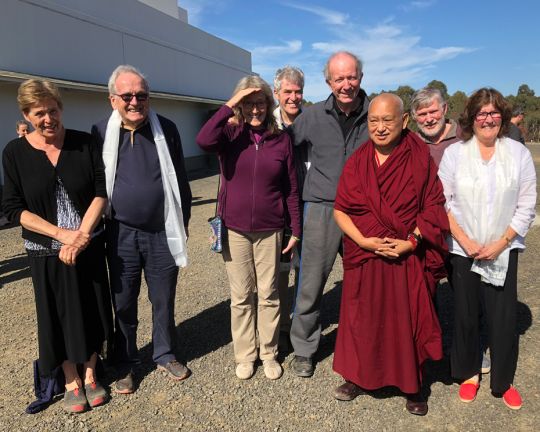
Students in the fourth week of the Bendigo Retreat who attended the 1978 November Kopan Course forty years ago. Owen Cole wrote, “In those days, many of us slept on the ground in a tent and had to take a bucket down to the local freezing Nepali spring in winter to bathe, but the Kopan courses in those days were an exhilarating experience for us all as they have been for the thousands who have attended them since.” From left, Gun Cisse (Sweden), Geoff Pullen (UK), Vicki Taylor (Sydney), Murray Wright (New Zealand), Owen Cole (Hayagriva), Kyabje Lama Zopa Rinpoche, Greg Carr (Hayagriva), Margaret Bohler (Sydney). Absent Ven. Thubten Gyatso. Photo by Ven. Roger Kunsang.
The retreat was attended by a cross section of FPMT students, traveling from near and far, including more than sixty-five ordained Sangha.
“Ninety students did the whole six-week retreat with almost four hundred taking part for at least part of it. There was an average of about 160 students in any week with about one-third of those from outside Australia,” Owen Cole wrote.
“Organizing the retreat involved creating a small village from nothing by setting up sixty accommodation tents as well as caravans, portable toilets and showers, a marquee (tent) dining hall, and a portable kitchen. Electricity for the kitchen came from a portable generator and with the number of people and lack of infrastructure, drinking water even had to be trucked into the site and sewage trucked out.
“The karma yoga with participants having to cooperate and get to know each other through jobs such as maintaining the altar, serving food, dish washing, cleaning toilets and showers, and ground maintenance also built a sense of community. Without this huge input of volunteer labor the retreat could not have happened.”
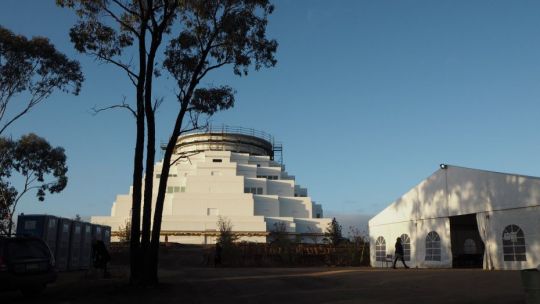
The Great Stupa and marquee, Australia, May 2018. Photo by Ven. Tenzin Tsultrim.
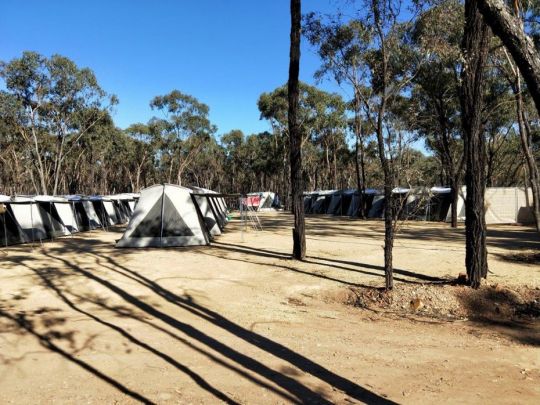
Tents set up for retreat participants at The Great Stupa of Universal Compassion, Australia, May 2018. Photo by Owen Cole.
The Long Life Puja
More than four hundred people attended the long life puja for Lama Zopa Rinpoche on Saturday, May 12, at The Great Stupa of Universal Compassion.
Resident geshes from FPMT Australia centers were there, including Geshe Thubten Rapten (Thubten Shedrup Ling), Geshe Phuntsok Tsultrim (Chenrezig Institute), Geshe Ngawang Samten (Vajrayana Institute), Geshe Lobsang Doga (Tara Institue), and Geshe Ngawang Sonam (Hayagriva Centre). Geshe Jampa Tharchin, resident geshe at Chandrakirti Centre in New Zealand, was also there, as well as Geshe Tenzin Zopa, an FPMT touring geshe who attended the entire retreat.
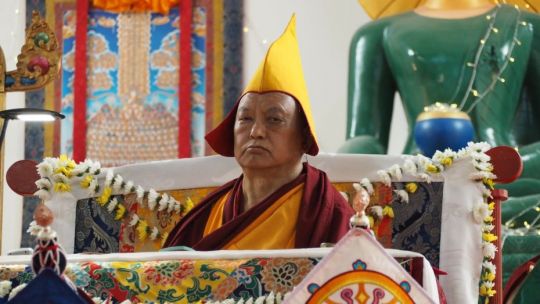
Lama Zopa Rinpoche during the long life puja for him, The Great Stupa of Universal Compassion, Australia, May 12, 2018. Photo by Ven. Tenzin Tsultrim.
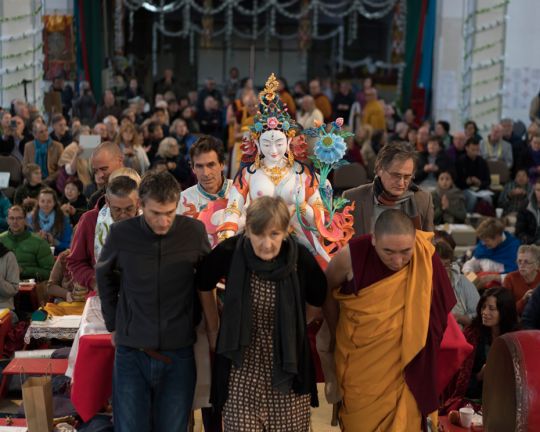
Students carrying in the White Tara statue offered to Rinpoche during the long life puja, The Great Stupa of Universal Compassion, Australia, May 2018. Photo by Ven. Lobsang Sherab.
Rinpoche entered the carefully arranged gompa to gracefully falling white flower petals.
During the puja, which lasted six hours, Rinpoche was offered a White Tara statue, sculpted by Bertrand Cayla over a period of a year and painted by Sonam Sherpa and Bertrand over a period of several months at Nalanda Monastery in France. The life-sized statute was shipped to Bendigo and filled by Geshe Thubten Rapten and Ven. Gyatso.
Vens. Thubten Dechen and Gyalten Wangmo offered the long life prayer to Rinpoche composed by Rangjung Neljorma Khadro Namsel Drönme (Khadro-la), masterfully sung to a Bhutanese tune. As they sang, it seemed as if sunlight illuminated the statue, creating an auspicious and touching moment.
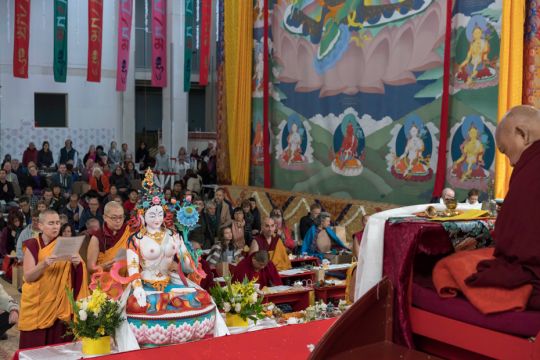
Vens. Dechen and Gyalten offer long life prayer by Khadro-la to Lama Zopa Rinpoche, The Great Stupa of Universal Compassion, Australia, May 2018. Photo by Ven. Lobsang Sherab.
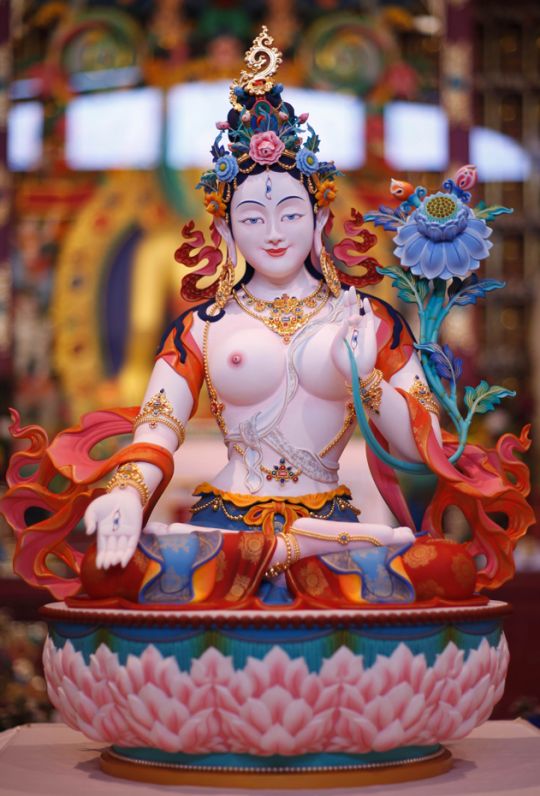
White Tara statue in France before being sent to Australia to be offered to Rinpoche. Photo by Bertrand Cayla.
Student strongly participated in the long life puja, singing from their hearts and receiving the blessings from Rinpoche.
After the puja, Rinpoche invited seventy-five people to lunch in a Nepali restaurant in Bendigo. Rinpoche offered the lunch as a way of showing appreciation to the people who have taken on important responsibilities at FPMT centers, including resident geshes and teachers, directors, spiritual program coordinators, board members, and so forth. It was a happy and relaxed time at the restaurant.
The next day before leaving Thubten Shedrup Ling, where he stayed during the retreat, Rinpoche led an incense puja in the garden of the monastery. Rinpoche traveled next to Adelaide, where he blesses Buddha House’s new building on May 20.
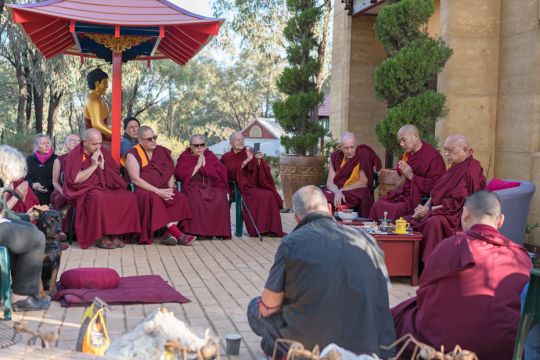
Lama Zopa Rinpoche doing incense puja at Thubten Shedrup Ling, Australia, May 2018. Photo by Ven. Lobsang Sherab.
“It was an incredible and moving retreat,” Ven. Holly said. “It was not like anything else I’ve experienced. It was such a precious time. The conditions of prayers and effort came together for a retreat of a life time.”
Watch Lama Zopa Rinpoche’s teachings from the Bodhicaryavatara and Rinjung Gyatsa Retreat in Australia:
https://fpmt.org/media/streaming/teachings-of-lama-zopa-rinpoche/lama-zopa-rinpoche-teachings-in-bendigo-2018/
Lama Zopa Rinpoche is the spiritual director of the Foundation for the Preservation of Mahayana Tradition (FPMT), a Tibetan Buddhist organization dedicated to the transmission of the Mahayana Buddhist tradition and values worldwide through teaching, meditation, and community service.
- Tagged: australia retreat 2018, geshe lhundub sopa rinpoche, great stupa of universal compassion, lama zopa rinpoche, lama zopa rinpoche long life puja, thubten gyatso, thubten shedrup ling, twelve links of dependent arising
11
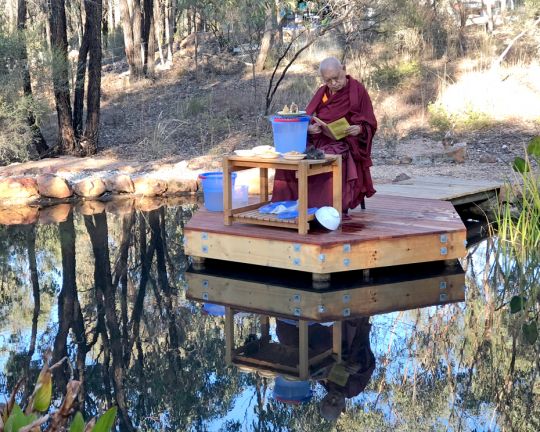
Lama Zopa Rinpoche offering to pretas and doing Dzambala practice at the lake near Thubten Shedrup Ling Monastery, Bendigo, Australia, April 2018. Photo by Ven. Roger Kunsang.
Lama Zopa Rinpoche explains how peace and happiness come from meditation in this teaching recently published in the Lama Yeshe Wisdom Archive April 2018 E-Letter.
Peace and happiness in life come when we free ourselves from the dissatisfied mind of desire. Satisfaction comes when we give ourselves freedom, or independence, from the unhappy mind of desire.
How do we free ourselves from the dissatisfied mind of desire and the other unhealthy minds that make our life unhappy? How do we fill up the emptiness in our heart? The answer is meditation. It is only through meditation practice that we can free ourselves from desire and other disturbing thoughts. And we then need to develop the good heart, not only not giving harm to other sentient beings but also benefiting them. Again that comes from meditation. That’s why we need to practice meditation.
No matter how many friends and other external things we have, that alone is not sufficient. We need friends, but no matter how many hundreds or even thousands of friends we have, that alone doesn’t bring us peace, happiness, and satisfaction. Even after we have found friends there is still something missing in our heart. We are not fully satisfied. That is because we have the dissatisfied mind of desire and lack loving kindness and compassion. Simply having friends is not sufficient to bring peace and happiness. We need to practice the good heart. What is missing is the good heart.
Also, no matter how much wealth we have, there’s still no peace, happiness, and satisfaction in our life. There is still something missing. Things are not perfect. Something else is needed. If we were able to obtain all the wealth in the world, or even if we were able to become just a millionaire, when we checked in our heart whether or not things were now perfect, we would still not be fully satisfied. There would still be something missing. There would be an empty place in our heart. This tells us that wealth alone is not sufficient to bring peace, happiness, and satisfaction.
What we need is something that frees us from the dissatisfied mind of desire and self-cherishing thought and brings satisfaction and the good heart. Again, the answer is meditation practice. This is what gives us freedom from the dissatisfied mind of desire, self-cherishing thought, and the other unhappy minds.
No matter how famous we are or how much power we have it is the same. Even if everyone in the whole world knew who we were, if we checked in our heart there would be something missing. Even though everything looked good on the outside, there would be something missing on the inside.
Again, what is missing is meditation practice, which transforms our mind from self-cherishing into cherishing other sentient beings, into loving kindness, compassion, and the good heart. Meditation also transforms the unhappy, dissatisfied mind of desire into the satisfied mind. Simply being famous or powerful cannot bring you this peace and happiness. Even if you are famous or powerful, it’s not enough. A free mind, a happy mind, a satisfied mind—all these come through meditation, not through external things. You have to obtain happiness from your own mind, through meditation. It is your own mind that stops your suffering and confusion; it is your own mind that brings you happiness.
Even if you had all the power in the world, if you didn’t have a good heart, that power could become dangerous. Without concern for others, the more power you got, the more dangerous you would become to other sentient beings in your country and in the world. It also means you would become more dangerous to yourself, since more harm to other sentient beings ultimately means more harm to yourself.
There is nothing wrong with having power—the problem is having power without having a good heart. Behind the power should be a good heart, which makes the power beneficial for the world and for all sentient beings. If there is no motivation of good heart for using the power, the power becomes like poison and is dangerous even to the person who has it. Having power is not sufficient. For the power to be safe, it has to come from the good heart.
You need meditation practice, even for your own peace, happiness, and satisfaction. It has to do with the mind, with your own mind. It’s not that somebody can transplant happiness into you, like transplanting a heart. The mind of a buddha or some other holy being can’t be transplanted into you. Happiness and satisfaction have to come from your own mind. You have to transform the minds that bring problems to you and to others into healthy, peaceful, positive minds—such as loving kindness, compassion, and altruism—which bring peace and happiness to you and to others.
“Happiness Comes from Your Own Mind” comes from teachings given by Lama Zopa Rinpoche in Auckland, New Zealand in 1990. This teaching was edited by Ven. Ailsa Cameron and published in Lama Yeshe Wisdom Archive April 2018 E-Letter:
https://www.lamayeshe.com/article/e-letter-no-178-april-2018
You can watch Lama Zopa Rinpoche teach during the Bodhicaryavatara and Rinjung Gyatsa Retreat at The Great Stupa of Universal Compassion in Bendigo, Australia, March 30-May 12, 2018.
- Find links to watch teachings LIVE:
https://fpmt.org/media/streaming/lama-zopa-rinpoche-live/ - Watch, read, and listen to all of Rinpoche’s teachings from Bendigo at anytime:
https://fpmt.org/media/streaming/teachings-of-lama- zopa-rinpoche/
More information, photos and updates about FPMT spiritual director Lama Zopa Rinpoche can be found on Rinpoche’s webpage on FPMT.org. If you’d like to receive news of Lama Zopa Rinpoche and FPMT via email, sign up to FPMT News.
4
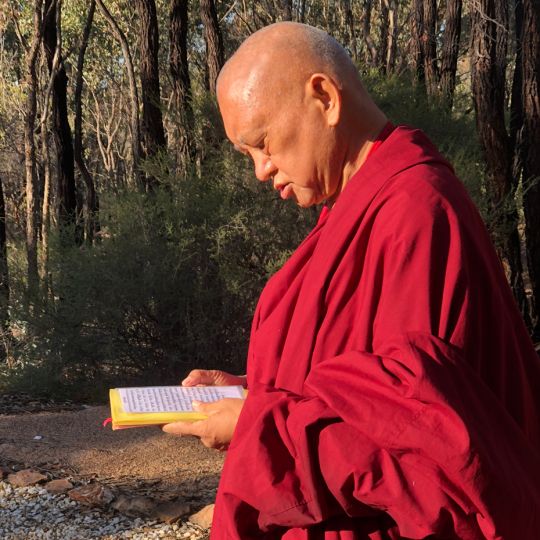
Lama Zopa Rinpoche offering to pretas and doing Dzambala practice at the lake near Thubten Shedrup Ling Monastery, where Rinpoche is staying during the retreat, Bendigo, Australia, April 2018. Photo by Ven. Roger Kunsang.
Lama Zopa Rinpoche continues to give moving and in-depth teachings at the retreat being held at The Great Stupa of Universal Compassion in Bendigo, Australia. It is now the fifth week of the six-week long Bodhicaryavatara and Rinjung Gyatsa Retreat. Rinpoche has started the Heruka initiation.
Often teaching two sessions a day, Rinpoche’s has focused extensively on correctly following the guru in thought and action. During the first three weeks, Rinpoche devoted time during many sessions to explaining the meaning of “Lama” from “LAMA TÖN PA CHOM DÄN … ,” the “Praise to Shakyamuni Buddha,” which retreat participants recite everyday. During a teaching in the fourth week, Rinpoche explained the rest of the verse.
Rinpoche has also been teaching on emptiness and how to meditate on it.
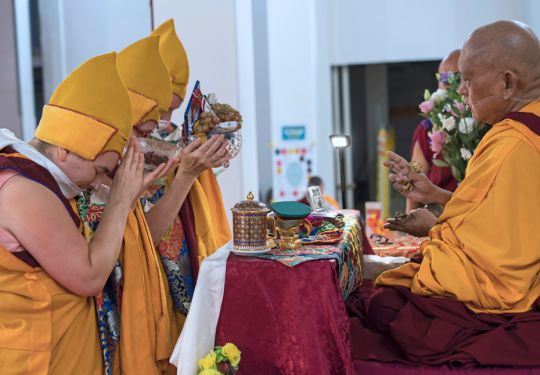
Tsog offering during the retreat, Great Stupa of Universal Compassion, Bendigo, Australia, April 2018. Photo by Ven. Lobsang Sherab.
Retreatants start at 5:30 or 6 a.m., taking precepts every other day, then doing morning prayers, prostrations by reciting the names of the 35 Buddhas, and then Lama Chöpa practice led by Ven. Thubten Dechen. In addition to the teaching sessions, there are daily discussion groups.
When Rinpoche isn’t teaching, different Geshes and senior teachers lead, such as Geshe Thubten Rapten, resident geshe at the nearby Thubten Shedrup Ling Monastery, Geshe Tenzin Zopa, Ven. Thubten Gyatso, Ven. Tony Beaumont, and many others. To close the day, retreatants do protector prayers, Vajrasattva practice, and dedication prayers, wrapping up at 10:30 or 11 p.m.
There are seventy-five Sangha doing the retreat, as well as four Geshes. One participant said that this retreat had been the highlight of her life.
Retreat participants have “great energy and are seriously doing the retreat,” according to Ven. Holly Ansett, who has been making sure the teachings are recorded on video and streamed live online. “Rinpoche is teaching an incredible amount,” Ven. Holly said. “And the teachings themselves have been beautiful and exquisite. They really move the mind.”
Watch Rinpoche teach on “LAMA TÖN PA CHOM DÄN DE …”:
https://youtu.be/HkM5tTZNgl8
You can watch Lama Zopa Rinpoche teach during the Bodhicaryavatara and Rinjung Gyatsa Retreat at The Great Stupa of Universal Compassion in Bendigo, Australia, March 30-May 12, 2018.
- Find links to watch teachings LIVE:
https://fpmt.org/media/streaming/lama-zopa-rinpoche-live/ - Watch, read, and listen to all of Rinpoche’s teachings from Bendigo at anytime:
https://fpmt.org/media/streaming/teachings-of-lama- zopa-rinpoche/
Lama Zopa Rinpoche is the spiritual director of the Foundation for the Preservation of Mahayana Tradition (FPMT), a Tibetan Buddhist organization dedicated to the transmission of the Mahayana Buddhist tradition and values worldwide through teaching, meditation, and community service.
27
Mindfulness of how things exist as merely labeled by the mind can bring peace and happiness, Lama Zopa Rinpoche explained while teaching at the 100 Million Mani Mantra Retreat in Italy.
“What you see, what you hear, what you think, what you taste, what you touch—all the six objects—are merely labeled by your mind. Every second, every minute, every hour, every day, from birth to death, everything is merely labeled by your mind, including your I,” Rinpoche says in the teaching shared in a nine-minute video clip.
By observing that everything from beginningless rebirths to endless future lives is merely imputed by your mind, your meditation on mindfulness becomes more profound, Rinpoche explains:
“It is so important; we can do meditation on just this for weeks, for months, for years. It is so good. It is so fantastic! It brings only calmness—only peace and happiness.
“In reality, nothing exists from its own side, including the I. There is no I from its own side. There is no action existing from its own side. There is no object existing from its own side. There is nothing—forms, sounds, smells, tastes, tangible objects, all this—that exists from there, except what is merely labeled by your mind. That is the reality!
“So do mindfulness of that for a weekend, then weeks, months, even years. After we receive many teachings on emptiness, this is what you have to practice, meditate on. You have to practice mindfulness of this in daily life, whether you are doing business, whether you are doing cooking, whatever work you are doing, secretary or whatever!
“For example, when somebody complains about you, makes you angry, at that time, meditate. Look at the I and think the I is merely labeled by mind. Look at the reality of the I, what exists, what doesn’t exist. Think the I is merely labeled by mind; meditate on that. The great anger [you feel] at the person who complains about you, abuses you, stops. The minute you think about how the I is merely labeled by the mind, the anger is gone.
“So therefore, you can see in daily life, when you are doing business, when life is so busy, when you are talking to people, whatever you are doing, part of your mind is in meditation on mindfulness. That is incredible. It gives peace and happiness in your heart, in your life.”
The quotes from Rinpoche have been lightly edited and are based on the unedited transcript of the 100 Million Mani Mantra retreat in Italy, which you can find here with video recordings of the complete teachings:
https://fpmt.org/media/streaming/teachings-of-lama-zopa-rinpoche/100-million-mani-mantra-retreat-2017/
Watch Lama Zopa Rinpoche teach during the Bodhicaryavatara and Rinjung Gyatsa Retreat at The Great Stupa of Universal Compassion in Bendigo, Australia, March 30-May 12, 2018.
- Find links to watch teachings LIVE:
https://fpmt.org/media/streaming/lama-zopa-rinpoche-live/ - Watch, read, and listen to all of Rinpoche’s teachings from Bendigo at anytime:
https://fpmt.org/media/streaming/teachings-of-lama- zopa-rinpoche/
Lama Zopa Rinpoche is the spiritual director of the Foundation for the Preservation of Mahayana Tradition (FPMT), a Tibetan Buddhist organization dedicated to the transmission of the Mahayana Buddhist tradition and values worldwide through teaching, meditation, and community service.
- Tagged: essential extract, lama zopa rinpoche, mindfulness, video
19
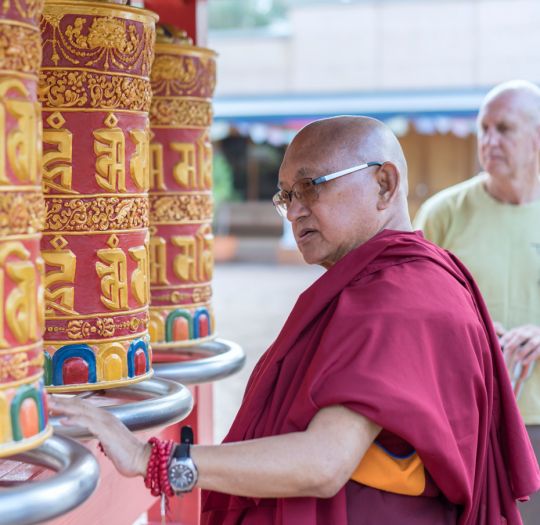
Lama Zopa Rinpoche spinning prayer wheels at Atisha Centre, Bendigo, Australia, April 2018. Photo by Ven. Lobsang Sherab.
“Achieving enlightenment by depending on Buddha, Victorious One, is exactly the same as achieving enlightenment by depending on sentient beings,” Lama Zopa Rinpoche teaches during a session of the 2017 Light of the Path retreat, captured in this six-minute video clip.
“By depending on the Buddha, you achieve enlightenment. So, you think the Buddha is so precious, so important. So why not [think this way about] sentient beings? Because you achieve enlightenment by depending on sentient beings. Buddha came from sentient beings, Dharma came from sentient beings, Sangha came from sentient beings—in whom you always take refuge when you begin a practice,” Rinpoche says.
Rinpoche reminds students that sentient beings are the source of every happiness up to enlightenment and should be regarded as most precious.
“So when you think, ‘there is ant, there is a worm, there is a worm being eaten by bird or chicken or something, or insects attacked by ants or something, mosquito or something,’ then you think, ‘The numberless buddhas came from this insect, numberless buddhas, as well as Dharma, as well as Sangha, the three rare precious ones, rare sublime ones, numberless.’”
“Achieving Dharma from the Buddha is the same as sentient beings, it is exactly the same, exactly the same. So as you respect the Buddha, why not respect the sentient beings?” Rinpoche says.
Watch Rinpoche teach “By Cherishing Sentient Beings You Will Achieve Enlightenment”:
https://youtu.be/g3SE_VpqoXw
Quoted text based on the unedited transcript for the 2017 Light for the Path retreat, which you can find here with video recordings of the complete teachings:
https://fpmt.org/media/streaming/teachings-of-lama-zopa-rinpoche/light-of-the-path-teachings-2017/
Watch Lama Zopa Rinpoche teach during the Bodhicaryavatara and Rinjung Gyatsa Retreat at The Great Stupa of Universal Compassion in Bendigo, Australia, March 30-May 12, 2018.
- Find links to watch teachings LIVE:
https://fpmt.org/media/streaming/lama-zopa-rinpoche-live/ - Watch, read, and listen to all of Rinpoche’s teachings from Bendigo at anytime:
https://fpmt.org/media/streaming/teachings-of-lama- zopa-rinpoche/
Lama Zopa Rinpoche is the spiritual director of the Foundation for the Preservation of Mahayana Tradition (FPMT), a Tibetan Buddhist organization dedicated to the transmission of the Mahayana Buddhist tradition and values worldwide through teaching, meditation, and community service.
- Tagged: essential extract, lama zopa rinpoche, video
16
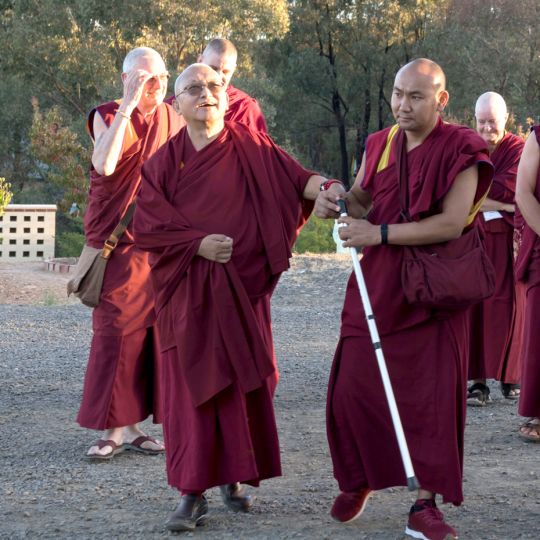
Lama Zopa Rinpoche with Ven. Thubten Tendar looking at The Great Stupa of Universal Compassion, Australia, March 2018. Photo by Ven. Lobsang Sherab.
Lama Zopa Rinpoche begins a third week of teachings at The Great Stupa of Universal Compassion in Bendigo, Australia, for the six-week long Bodhicaryavatara and Rinjung Gyatsa Retreat. During the first two weeks of the retreat, Rinpoche’s teachings, more than two dozen, have been streamed live online. In addition, recordings of the teachings can be watched online.
Rinpoche so far has spent a lot of time giving instructions on how to do prayers and practices, such as Lama Chöpa; on generating correct motivation; on guru devotion; and on other topics.
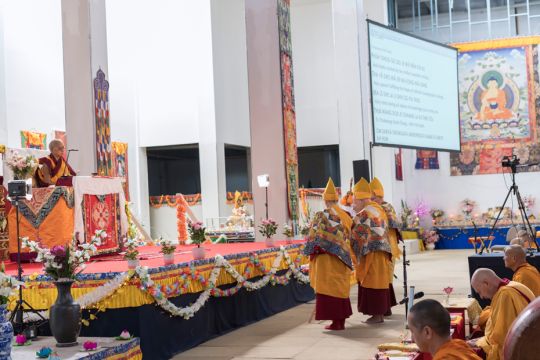
Nuns doing bath offering during Lama Chöpa Jorcho, The Great Stupa of Universal Compassion, Australia, April 2018. Photo by Ven. Lobsang Sherab.
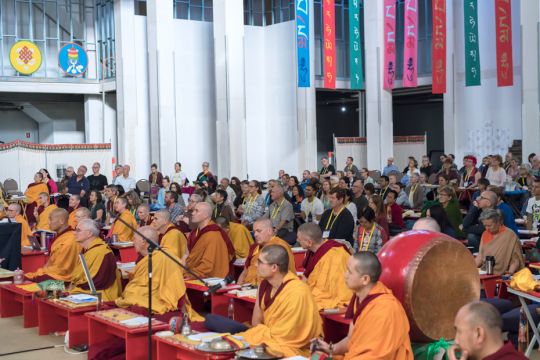
Retreat participants listening to teaching, The Great Stupa of Universal Compassion, Australia, April 2018. Photo by Ven. Lobsang Sherab.
The retreat is being held in the large gompa inside of The Great Stupa of Universal Compassion. Ven. Holly Ansett shared that it is a very good setting for the retreat, that everything has been well arranged, and that retreat organizers have thought of everything.
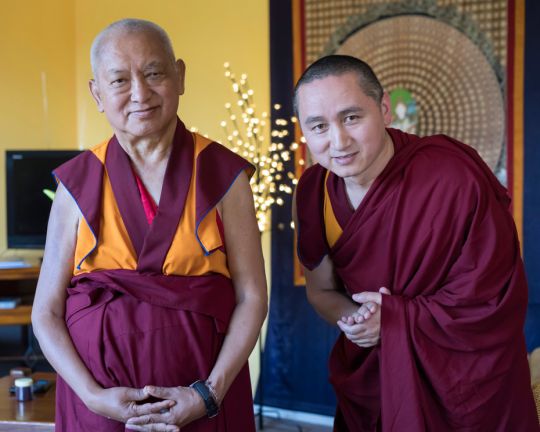
Lama Zopa Rinpoche with Geshe Tenzin Zopa, Bendigo, Australia, April 2018. Photo by Ven. Lobsang Sherab.
The retreat is well attended, with many Sangha and long-time senior students there. Geshe Thubten Rapten, resident geshe at the nearby Thubten Shedrup Ling Monastery, attends many of the sessions with Rinpoche and teaches some of the afternoon sessions. Geshe Tenzin Zopa is attending the entire retreat. Michael Losang Yeshe is serving as the retreat leader. Approximately 180 people attended the first week.
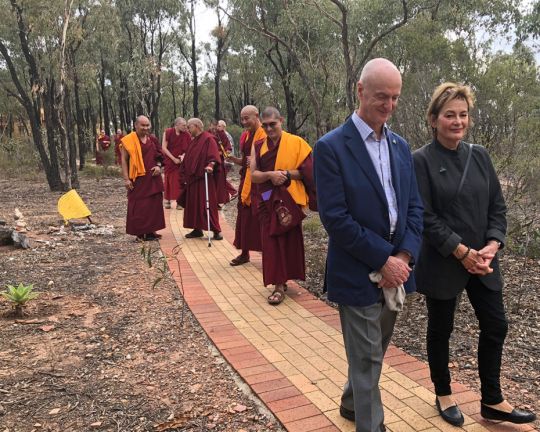
Walking to The Great Stupa of Universal Compassion from Thubten Shedrup Ling, Australia, April 2018. Photo by Ven. Lobsang Sherab.
Rinpoche is staying at Thubten Shedrup Ling, which is adjacent to The Great Stupa, and walks from there to give teachings. On the walks, Rinpoche is very careful not to step on any ants on the path and reminds others to do the same.
On one day, Rinpoche received a tour of The Great Stupa, including visiting the top of the stupa.
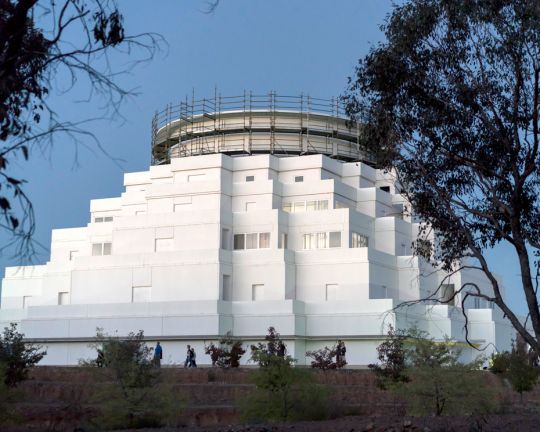
The Great Stupa of Universal Compassion, Australia, April 2018. Photo by Ven. Lobsang Sherab.
Rinpoche also visited Atisha Centre, which is next to The Great Stupa.
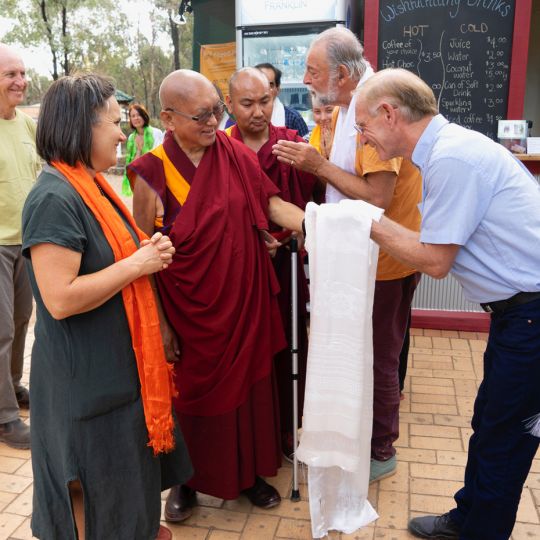
Lama Zopa Rinpoche being greeted by current Atisha Centre director Ruby Karmay and former director Liam Chambers, during Rinpoche’s visit to the center’s courtyard, Australia, April 2018. Photo by Andy Melnic.
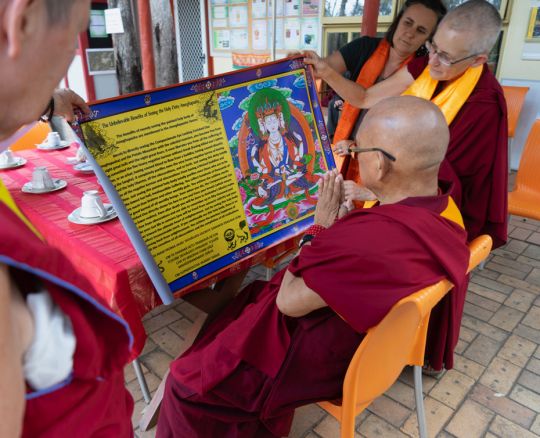
Rinpoche looking at a banner of Amoghapasha during visit to Atisha Centre, Australia, April 2018. Photo by Andy Melnic.
Watch Lama Zopa Rinpoche teach during the Bodhicaryavatara and Rinjung Gyatsa Retreat at The Great Stupa of Universal Compassion in Bendigo, Australia, March 30-May 12, 2018.
- Find links to watch teachings LIVE:
https://fpmt.org/media/streaming/lama-zopa-rinpoche-live/ - Watch, read, and listen to all of Rinpoche’s teachings from Bendigo at anytime:
https://fpmt.org/media/streaming/teachings-of-lama- zopa-rinpoche/
Lama Zopa Rinpoche is the spiritual director of the Foundation for the Preservation of Mahayana Tradition (FPMT), a Tibetan Buddhist organization dedicated to the transmission of the Mahayana Buddhist tradition and values worldwide through teaching, meditation and community service.
- Tagged: atisha centre, australia retreat 2018, Geshe Tenzin Zopa, Geshe Thubten Rapten, great stupa of universal compassion, lama zopa rinpoche, thubten shedrup ling
13
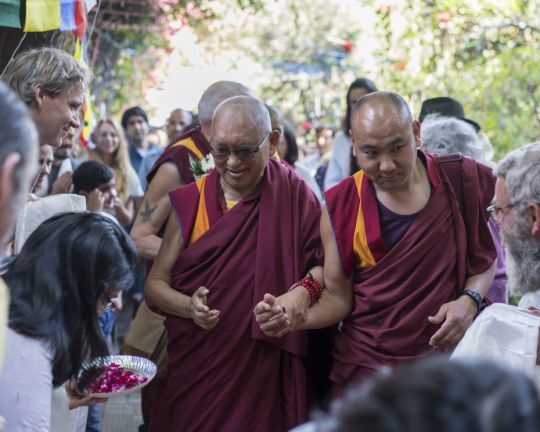
Lama Zopa Rinpoche arriving at Tushita Mahayana Meditation Centre, Delhi, India, March 2018. Photo by Ven. Lobsang Sherab.
Rinpoche visited Tushita Mahayana Meditation Centre in New Delhi, India, before traveling to the Bodhicaryavatara and Rinjung Gyatsa Retreat in Bendigo, Australia. On March 10-11, Rinpoche gave teachings, including oral transmissions of the Golden Light Sutra and of “The Method to Transform a Suffering Life into Happiness (Including Enlightenment),” at Tushita Mahayana Meditation Centre. Center director Renuka Singh shared this report:
Initially, Lama Zopa Rinpoche, spiritual director of FPMT and Tushita Mahayana Meditation Centre, was expected to come and teach in November 2017. The Delhi pollution somehow conspired to keep Rinpoche away. Finally, the auspicious time of his arrival in Delhi was on International Women’s Day, March 8, 2018.
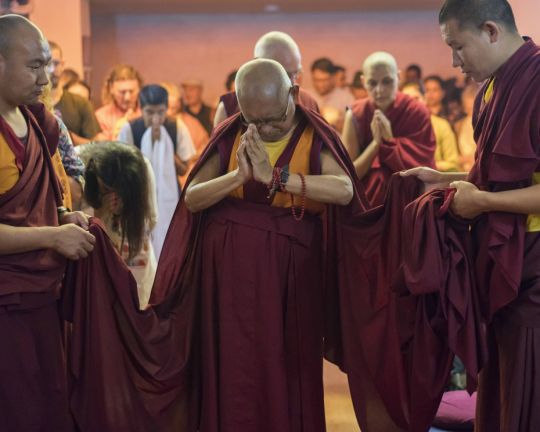
Lama Zopa Rinpoche prostrating before giving the oral transmission of the Sutra of Golden Light, Tushita Mahayana Meditation Centre, Delhi, India, March 2018. Photo by Ven. Lobsang Sherab.
The highlight of Rinpoche’s visit was the two-day teaching at Tushita. Dharma nectar blessings came in the form of the oral transmission of the sublime Golden Light Sutra on day one. Subduing one’s mind was greatly emphasized.
On day two, Rinpoche gave the oral transmission of “The Method to Transform a Suffering Life into Happiness (Including Enlightenment).” This included the generation of a good motivation and mantras for blessing the speech, malas, and so forth.
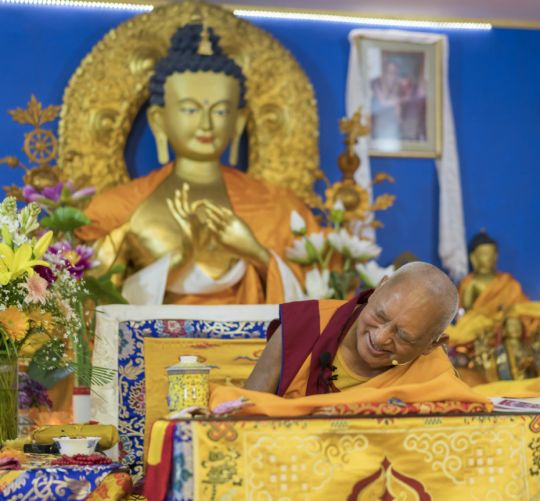
Lama Zopa Rinpoche at Tushita Mahayana Meditation Centre, Delhi, India, March 2018. Photo by Ven. Lobsang Sherab.
Rinpoche also granted refuge to forty people. Ninety percent of whom were Indians. Rinpoche concluded the teachings with Guru Puja, which ended at 1 a.m.
The gompa was jam-packed for the teachings—around 100 to 150 attendees of all ages were present. However, there was numerical preponderance of young people. Prof. Robert Thurman attended the first day. Several current and former directors of other Indian centres were also present.
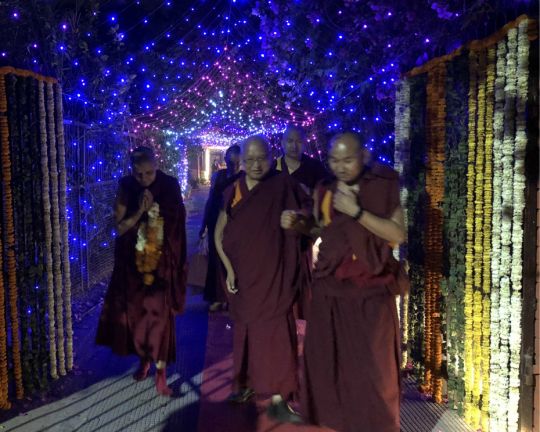
Rinpoche and the light offerings at Tushita Mahayana Meditation Centre, Delhi, India, March 2018. Photo by Ven. Lobsang Sherab.
The hard work of center spiritual program coordinator Ven. Gyalten Samten, especially, as well as of Ven. Kabir Saxena and all the volunteers and sponsors was highly appreciated. Rinpoche praised the decoration and light offerings at the center emphatically. Ven. Kabir gave the longest entertaining vote of thanks ever. As director, I was extremely honored and happy to host Rinpoche. The wait for Rinpoche’s next visit has already begun!
Watch Lama Zopa Rinpoche teach during the Bodhicaryavatara and Rinjung Gyatsa Retreat at The Great Stupa of Universal Compassion in Bendigo, Australia, March 30-May 12, 2018.
- Find links to watch teachings LIVE:
https://fpmt.org/media/streaming/lama-zopa-rinpoche-live/ - Watch, read, and listen to all of Rinpoche’s teachings from Bendigo at anytime:
https://fpmt.org/media/streaming/teachings-of-lama- zopa-rinpoche/
Lama Zopa Rinpoche is the spiritual director of the Foundation for the Preservation of Mahayana Tradition (FPMT), a Tibetan Buddhist organization dedicated to the transmission of the Mahayana Buddhist tradition and values worldwide through teaching, meditation and community service.
- Home
- News/Media
- Study & Practice
- About FPMT Education Services
- Latest News
- Programs
- New to Buddhism?
- Buddhist Mind Science: Activating Your Potential
- Heart Advice for Death and Dying
- Discovering Buddhism
- Living in the Path
- Exploring Buddhism
- FPMT Basic Program
- FPMT Masters Program
- FPMT In-Depth Meditation Training
- Maitripa College
- Lotsawa Rinchen Zangpo Translator Program
- Universal Education for Compassion & Wisdom
- Online Learning Center
- Prayers & Practice Materials
- Overview of Prayers & Practices
- Full Catalogue of Prayers & Practice Materials
- Explore Popular Topics
- Benefiting Animals
- Chenrezig Resources
- Death & Dying Resources
- Lama Chopa (Guru Puja)
- Lama Zopa Rinpoche: Compendium of Precious Instructions
- Lama Zopa Rinpoche: Life Practice Advice
- Lama Zopa Rinpoche Practice Series
- Lamrim Resources
- Mantras
- Prayer Book Updates
- Purification Practices
- Sutras
- Thought Transformation (Lojong)
- Audio Materials
- Dharma Dates – Tibetan Calendar
- Translation Services
- Publishing Services
- Teachings and Advice
- Find Teachings and Advice
- Lama Zopa Rinpoche Advice Page
- Lama Zopa Rinpoche: Compendium of Precious Instructions
- Lama Zopa Rinpoche Video Teachings
- ༧སྐྱབས་རྗེ་བཟོད་པ་རིན་པོ་ཆེ་མཆོག་ནས་སྩལ་བའི་བཀའ་སློབ་བརྙན་འཕྲིན།
- Podcasts
- Lama Yeshe Wisdom Archive
- Buddhism FAQ
- Dharma for Young People
- Resources on Holy Objects
- Ways to Offer Support
- Centers
- Affiliates Area
- Teachers
- Projects
- Charitable Projects
- Make a Donation
- Applying for Grants
- News about Projects
- Other Projects within FPMT
- Support International Office
- Projects Photo Galleries
- Give Where Most Needed
- FPMT
- Shop
Translate*
*powered by Google TranslateTranslation of pages on fpmt.org is performed by Google Translate, a third party service which FPMT has no control over. The service provides automated computer translations that are only an approximation of the websites' original content. The translations should not be considered exact and only used as a rough guide.Your up and down emotions are like clouds in the sky; beyond them, the real, basic human nature is clear and pure.


